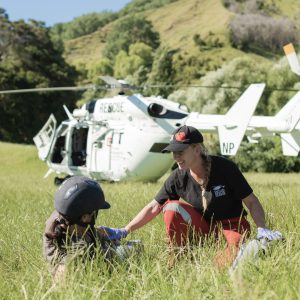TRAVELLING to Gisborne for work in the weeks after Cyclone Gabrielle, Kelley Waite would pack what she needed for overnight stays . . . and a chainsaw.
“There were always trees down,” she says of the Tiniroto Road route from her home at Marumaru, inland from Wairoa, “so you just had to be prepared”.
As the state of the road worsened Kelley opted to travel via Wairoa, making it an 80-minute trip to the Gisborne hangar where she worked as crewman with the Trust Tairāwhiti Eastland Rescue Helicopter.
At the time she had already given up her role as base manager with plans for her, her mother Della and her pre-school daughter Kenzyie to leave the family home of more than 40 years and move to Hastings, closer to the care centre where her father, Glyn, has lived since suffering a stroke in 2022.
In the post-cyclone environment she opted to stay in Gisborne, but by late October the trio had secured a new home on six hectares at Maraekakaho, inland from Hastings, and Kelley had been snapped up to crew for the Lowe Corporation Rescue Helicopter.
As she prepared to make the move Kelley was looking forward to the luxury of 12-hour shifts, a change from the 24-hour roster the Eastland crewmen will work until their much anticipated fourth team member arrives in December of this year.
“It only takes half-an-hour to drive to the hangar at the Hastings hospital, and another 10 minutes to get to dad’s care centre, which is going to free up so much time,” she says.
“But the Hawke’s Bay service also does hundreds of missions a year so I’m anticipating a busy summer season.”
Kelley Waite started her career in helicopter rescue after 16 years with the Royal New Zealand Air Force, following in the footsteps of her grandad Alan, who’d been a radio technician in the British Royal Air Force, her nana Betty, who’d driven bulldozers as a member of the Women In The Air Force (WAF) programme and her maternal grandfather Rex, who’d been a member of the British Army.
For her own trade training, she started in telecommunications then retrained as a helicopter crewman.
“I had spent years working with and going on deployment with 3 Squadron before I decided to become a more active part of the team.” she says.
At the time one of just five women to have trained as helicopter crewmen with the RNZAF, Kelley worked in that role for five years until leaving in 2016.
By the end of that year she had signed on with Search and Rescue Services Ltd (SRSL), the company formed by five rescue helicopter trusts (including Gisborne’s Eastland Helicopter Rescue Trust) to manage ops across eight North Island bases.
For the next three years she worked in bases at Palmerston North, Taupo, Waikato and Tauranga before joining the Gisborne team to be closer to her parents who, she says, have been a big help in caring for now-four-year-old Kenzyie.
“It was tough returning to work after Kenzyie was born as I was breast-feeding and at the same time undertook the mandatory Diploma in Paramedicine, which required 18 months of full-time extramural study on top of a working week,” she says.
“Then when I relocated to Gisborne in January 2020 the base manager of the time had just left, so I put my hand up for the job as I knew it was something I could do and do well.”
Now, after her service with the Eastland team, she leaves the Gisborne base in good health.
“I already knew that, thanks to the (Eastland Helicopter Rescue) Trust, the base had a fantastic hangar with great facilities, but it has taken until this year to get NASO (National Ambulance Sector Office) approval for a full in-house team of four pilots, four crewmen and the same number of critical care flight paramedics,” she says.
“It’s all based on the number of jobs you are doing and the KPIs (Key Performance Indicators) being met, so I guess getting that approval now is reward for all the hard work the team has been doing.”
Fantastic support from ambulance and other first responders throughout the district had made the job easier, says Kelley. As had working with an “awesome” crew of professionals who were laid back “but very, very serious about the work they do.”
“Gisborne is without doubt the best base I have ever worked at,” she says.
“Here, the trustees are super-involved and are great at supporting the SRSL crew at a local level.
“They really care about their community and fight hard to ensure their people get the critical service they need.”
CAPTION: ON A MISSION: Despite the drama of the last year – including two cyclones and three states of emergency – crewman Kelley Waite (pictured) says her most memorable mission with the Trust Tairāwhiti Eastland Rescue Helicopter occurred in 2022 at Mahia, on a stunning blue-sky day, with pilot Tony Brice and critical care flight paramedic Richard Curtis. “It was a unique location – landing on the rocks at low tide – and a unique injury . . . the patient had a stingray barb through his elbow and had to use his sock to tie a tourniquet,” she says. “That uniqueness – plus the ultra-fast turnaround taking 10 minutes to get there, 10 minutes on scene, and 15 minutes to get him to hospital – is what makes it stick in the mind. And having a good outcome certainly doesn’t hurt.”
